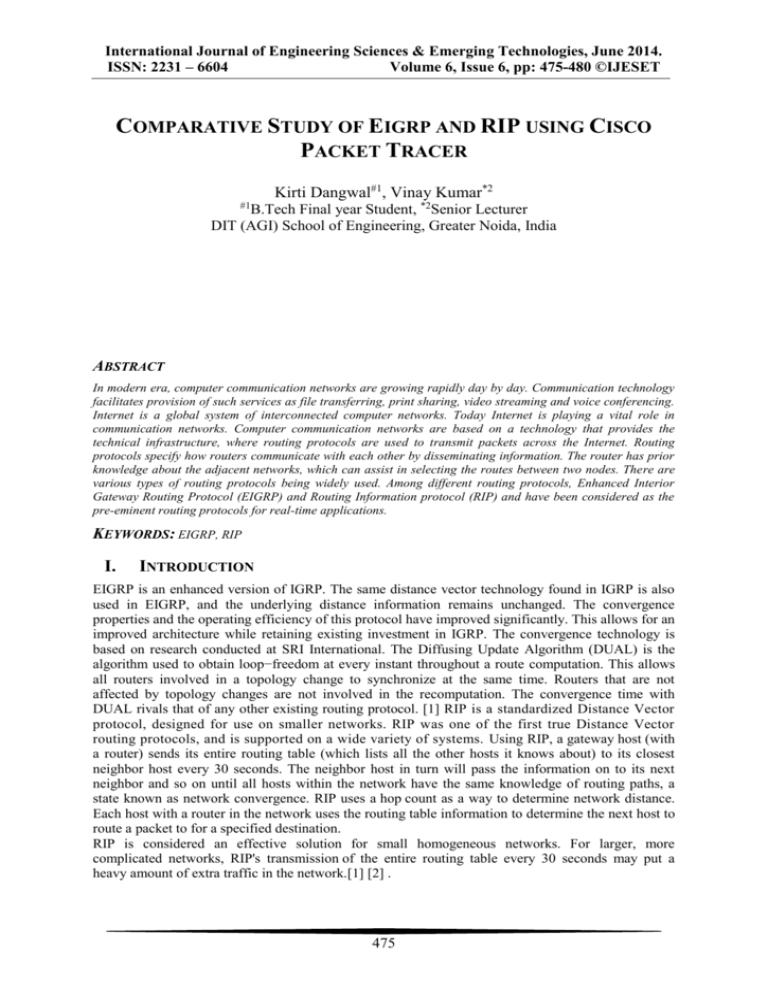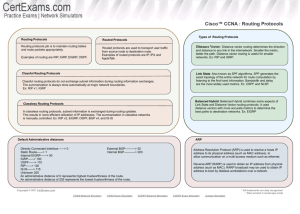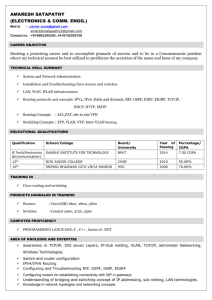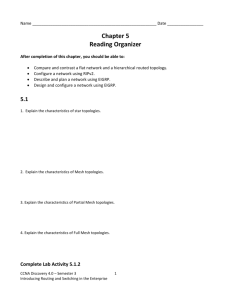comparative study of eigrp and rip using cisco packet tracer
advertisement

International Journal of Engineering Sciences & Emerging Technologies, June 2014. ISSN: 2231 – 6604 Volume 6, Issue 6, pp: 475-480 ©IJESET COMPARATIVE STUDY OF EIGRP AND RIP USING CISCO PACKET TRACER Kirti Dangwal#1, Vinay Kumar*2 #1 B.Tech Final year Student, *2Senior Lecturer DIT (AGI) School of Engineering, Greater Noida, India ABSTRACT In modern era, computer communication networks are growing rapidly day by day. Communication technology facilitates provision of such services as file transferring, print sharing, video streaming and voice conferencing. Internet is a global system of interconnected computer networks. Today Internet is playing a vital role in communication networks. Computer communication networks are based on a technology that provides the technical infrastructure, where routing protocols are used to transmit packets across the Internet. Routing protocols specify how routers communicate with each other by disseminating information. The router has prior knowledge about the adjacent networks, which can assist in selecting the routes between two nodes. There are various types of routing protocols being widely used. Among different routing protocols, Enhanced Interior Gateway Routing Protocol (EIGRP) and Routing Information protocol (RIP) and have been considered as the pre-eminent routing protocols for real-time applications. KEYWORDS: EIGRP, RIP I. INTRODUCTION EIGRP is an enhanced version of IGRP. The same distance vector technology found in IGRP is also used in EIGRP, and the underlying distance information remains unchanged. The convergence properties and the operating efficiency of this protocol have improved significantly. This allows for an improved architecture while retaining existing investment in IGRP. The convergence technology is based on research conducted at SRI International. The Diffusing Update Algorithm (DUAL) is the algorithm used to obtain loop−freedom at every instant throughout a route computation. This allows all routers involved in a topology change to synchronize at the same time. Routers that are not affected by topology changes are not involved in the recomputation. The convergence time with DUAL rivals that of any other existing routing protocol. [1] RIP is a standardized Distance Vector protocol, designed for use on smaller networks. RIP was one of the first true Distance Vector routing protocols, and is supported on a wide variety of systems. Using RIP, a gateway host (with a router) sends its entire routing table (which lists all the other hosts it knows about) to its closest neighbor host every 30 seconds. The neighbor host in turn will pass the information on to its next neighbor and so on until all hosts within the network have the same knowledge of routing paths, a state known as network convergence. RIP uses a hop count as a way to determine network distance. Each host with a router in the network uses the routing table information to determine the next host to route a packet to for a specified destination. RIP is considered an effective solution for small homogeneous networks. For larger, more complicated networks, RIP's transmission of the entire routing table every 30 seconds may put a heavy amount of extra traffic in the network.[1] [2] . 475 International Journal of Engineering Sciences & Emerging Technologies, June 2014. ISSN: 2231 – 6604 Volume 6, Issue 6, pp: 475-480 ©IJESET II. LITERATURE REVIEW The Routing Information Protocol, or RIP, as it is more commonly called, is one of the most enduring of all routing protocols. RIP has four basic components: routing update process, RIP routing metrics, routing stability, and routing timers. Devices that support RIP send routing-update messages at regular intervals and when the network topology changes. These RIP packets contain information about the networks that the devices can reach, as well as the number of routers or gateways that a packet must travel through to reach the destination address. [3] RIP adheres to the following Distance Vector characteristics: RIP sends out periodic routing updates (every 30 seconds) RIP sends out the full routing table every periodic update RIP uses a form of distance as its metric (in this case, hop count) RIP uses the Bellman-Ford Distance Vector algorithm to determine the best “path” to a particular destination. A. RIP 1) RIPv1 A classful protocol, broadcasts updates every 30 seconds, hold-down period 180 seconds. Hop count is metric (Maximum 15). RIP supports up to six equal-cost paths to a single destination, where all six paths can be placed in the routing table and the router can load-balance across them. The default is actually four paths, but this can be increased up to a maximum of six. Remember that an equal-cost path is where the hop count value is the same. RIP will not load-balance across unequal-cost paths [1] [2] [3] 2) RIPv2 RIPv2 uses multicasts, version 1 use broadcasts, RIPv2 supports triggered updates—when a change occurs, a RIPv2 router will immediately propagate its routing information to its connected neighbors. RIPv2 is a classless protocol. RIPv2 supports variable-length subnet masking(VLSM) RIPv2 supports authentication. You can restrict what routers you want to participate in RIPv2. This is accomplished using a hashed password value. In general, distance-vector protocols are simpler to configure and to understand than link-state protocols. They are also typically less processor intensive, freeing more of the router to other tasks, such as forwarding packets. Their major drawbacks, though, are often the result of their simplicity. One of the chief drawbacks is that there is typically no indication of how a router knows about a destination that it has included in an update. [2] [3] [4]. The routing information protocol uses the following timers as part of its operation: Update Timer Invalid Timer Flush Timer Hold-down Timer B. EIGRP Enhanced Interior Gateway Routing protocol (EIGRP) is an interior gateway protocol suited for many different topologies and media. In a well-designed network, EIGRP scales well and provides extremely quick convergence times with minimal network traffic. Some of the advantages of EIGRP are: Very low usage of network resources during normal operation; only hello packets are transmitted on a stable network when a change occurs, only routing table changes are propagated, not the entire routing table; this reduces the load the routing protocol itself places on the network rapid convergence times for changes in the network topology(in some situations convergence can be almost instantaneous) 476 International Journal of Engineering Sciences & Emerging Technologies, June 2014. ISSN: 2231 – 6604 Volume 6, Issue 6, pp: 475-480 ©IJESET EIGRP is an enhanced distance vector protocol, relying on the Diffused Update Algorithm (DUAL) to calculate the shortest path to a destination within a network. EIGRP is an enhanced version of IGRP. The same distance vector technology found in IGRP is also used in EIGRP, and the underlying distance information remains unchanged. The convergence properties and the operating efficiency of this protocol have improved significantly. This allows for an improved architecture while retaining existing investment in IGRP. The Diffusing Update Algorithm (DUAL) is the algorithm used to obtain loop-freedom at every instant throughout a route computation. This allows all routers involved in a topology change to synchronize at the same time. Routers that are not affected by topology changes are not involved in the recomputation. The convergence time with DUAL rivals that of any other existing routing protocol. [3] [4] [5] [1]. 1) EIGRP has four basic components: Neighbor discovery/recovery Reliable transport Protocol DUAL Finite State Machine Protocol Dependent Modules 2) EIGRP uses five packet types: Hello/Acknowledge Updates Queries Replies Requests Tables 1 RIP vs. EIGRP PROPERTIES RIP EIGRP IPV6 version/update Type Administrative distance Max hop count RIPng Distance vector 120 EIGRP hybrid 90 15 Network size Algorithm Convergence VLSM small Bellman-ford slow Yes in v2 not in v1 Full table every 30sec more Hop count 100 (by default) Small to large Dual Fast Yes Routing updates Bandwidth usage Metric Every 5sec Less Bandwidth n delay EIGRP, instead of counting on full periodic updates to re-converge, builds a topology table from each of its neighbor's advertisements (rather than discarding the data), and converges by either looking for a likely loop-free route in the topology table, or, if it knows of no other route, by quering its neighbors. [1] [7] [8] It is apparent that EIGRP must provide: a system where it sends only the updates needed at a given time; this is accomplished through neighbor discovery and maintenance a way of determining which paths a router has learned are loop-free a process to clear bad routes from the topology tables of all routers on the network a process for querying neighbors to find paths to lost destinations C. EIGRP Commercial implementation EIGRP does not require a hierarchical network design to operate efficiently. EIGRP is protocol independent, apart from ipv4 /6 it also supports IPX and AppleTalk, customers who are using these protocols can leverage the protocol independent EIGRP capabilities to achieve higher return on investments. 477 International Journal of Engineering Sciences & Emerging Technologies, June 2014. ISSN: 2231 – 6604 Volume 6, Issue 6, pp: 475-480 ©IJESET EIGRP is less complex to implement and it also offers efficient route calculations when compared with OSPF, e.g. EIGRP uses bandwidth, delay, reliability and load when calculating optimal routes where as OSPF only takes bandwidth into consideration when calculating optimal routes. Keeping the above points in mind, EIGRP will be more viable commercially provided that it’s a full end to end Cisco implementation; EIGRP can also redistribute routing information with other routing protocol with router redistribution. III. COMPARATIVE ANALYSIS The first question we should make ourselves is why routing protocols are so important. Routing is the act of sending information from a source to a destination. Usually, this information passes through some intermediate devices. The purpose of routing protocols is to provide these intermediate devices the necessary information to send the packet correctly. So, the importance of routing protocols is such that without them the different devices that make up a network are not able to communicate with each other. All routing protocols are defined based on an algorithm. This algorithm must describe some procedures in order to make the routing protocols operate correctly. These procedures are: A procedure to receive and send information about the network. A procedure to find the best path to a destination and install the route in the routing table. And finally, a procedure to detect, react and inform to other devices about changes in the network topology. The two main existing algorithms are Bellman-Ford algorithm and DUAL. Depending on which algorithm is used, the routing protocols are classified in Distance Vector or hybrid, respectively. The fundamental difference between them is how they implement the procedures mentioned above. SIMULATION AND RESULTS A. Problem Description and Main Contribution The main goal of this project is to compare the proposed routing protocols and to evaluate them based on some performance metrics. This evaluation is performed theoretically and by simulation. EIGRP is a Cisco proprietary hybrid-vector protocol supporting both distance and link based on Diffusing Update Algorithm (DUAL). The cost of EIGRP is calculated on the basis of bandwidth and delay. In contrast, RIP is not a Cisco proprietary. RIP is a distance vector protocol based on Bellman-ford. The RIP routing protocol is calculated based on hop count. These protocols use different algorithm to route the packets and this may vary the route processing delay. As a consequence, the impact of different algorithm can affect the overall network performance. So, the main contributions of this project are: To design two network models that are configured respectively with EIGRP and RIP in order to evaluate the EIGRP and RIP performance. To simulate these network models with packets transfer and to observe how the performance varies from the EIGRP network to the RIP network. To report the simulated results and to analyze them. It carry out the network simulations, CISCO Packet tracer 5.0 simulator is used This work is divided into three sections. First of all, we will see a theoretical analysis of the three routing protocols under study. This analysis has been done from a comparative point of view. Secondly, we will see the methodology used to make the design and implementation of a baseline scenario on which we will test the different routing protocols. We have done this practical analysis with the networks simulation tool CISCO PACKET TRACER. Finally, we will see some of the obtained results and validate the conclusions arising from their analysis. B. Simulator Cisco Packet Tracer is a powerful network simulation program that allows students to experiment with network behavior and ask “what if” questions. As an integral part of the 478 International Journal of Engineering Sciences & Emerging Technologies, June 2014. ISSN: 2231 – 6604 Volume 6, Issue 6, pp: 475-480 ©IJESET Networking Academy comprehensive learning experience, Packet Tracer provides simulation, visualization, authoring, assessment, and collaboration capabilities and facilitates the teaching and learning of complex technology concepts. Packet Tracer supplements physical equipment in the classroom by allowing students to create a network with an almost unlimited number of devices, encouraging practice, discovery, and troubleshooting. The simulation-based learning environment helps students develop 21st century skills such as decision making, creative and critical thinking, and problem solving. Packet Tracer complements the Networking Academy curricula, allowing instructors to easily teach and demonstrate complex technical concepts and networking systems design. Packet Tracer feature: The current version of Packet Tracer supports an array of simulated Application Layer protocols, as well as basic routing with RIP, OSPF, and EIGRP, to the extents required by the current CCNA curriculum. While Packet Tracer aims to provide a realistic simulation of functional networks, the application itself utilizes only a small number of features found within the actual hardware running a current Cisco IOS version. Thus, Packet Tracer is unsuitable for modeling production networks. With the introduction of version 5.3, several new features were added, including BGP. C. Result Analysis We divide our work into two parts. First of all, we design a network model with EIGRP, simulate it by using CISCO packet tracer and observe the impact of using EIGRP alone for real time applications. Secondly, in the same network scenario, we implement RIP instead of EIGRP and simulate the network model to observe the impact of using RIP alone for real time applications. We compare and evaluate performance of EIGRP and RIP protocols based on quantitative metrics such as convergence duration, packet delay variation, end-to-end delay, packet loss and throughput. We employ PACKET TRACER as a simulator to evaluate and to analyze the comparative performance of these routing protocols. EIGRP Scenario In this scenario, EIGRP routing protocol is enabled first for all routers on the network, i.e. 23 routers. After configuring routing protocols, frame relay is enabled and the packet transfer rate is evaluated. RIP Scenario First task is to set routing configuration RIP as a routing protocol for this network topology. After configuring, frame relay is enabled connecting two distant routers. Now as RIP supports small networks, those too only 16 routers is the limit. The performance is evaluated likewise The simulations have revealed the major constraints of RIPv2 protocol. The hybrid protocols improve the distance vector protocols shortcomings, especially those related to the network scalability and the adaptability to different types of topologies. In view of this, EIGRP has functions in both link state and distance vector protocols. Therefore, it provides better convergence, delay in accordance with available bandwidth while deciding the rate at which it transmits update. A detailed simulation study helped to find out the best protocol out of two. Convergence time is faster than RIP networks, because EIGRP network can learn the topology information and updates more rapidly. The average approximate round trip time of EIGRP is 14.2ms (millisecond) and that of rip is 16.6ms. This packet sending rate of EIGRP is less of EIRGP as compared to rip. We also found that the packet loss in the EIGRP network is less than in RIP network. In the future, a research work will be done on the explicit features of EIGRP protocols in the IPv4/IPv6 environment. Security analysis for EIGRP can also be done. [1] [3] [5]. Table 2 Result Summary PROPERTIES Average approx round trip time Convergence time Network size Administrative distance EIGRP 14.2ms fast Small to large 90 479 RIP 16.6ms slow Restricted to small 120 International Journal of Engineering Sciences & Emerging Technologies, June 2014. ISSN: 2231 – 6604 Volume 6, Issue 6, pp: 475-480 ©IJESET Administrative distance 150 100 Administrative distance 50 0 RIP EIGRP Administrative distance between RIP & EIGRP Average round trip time 17 16 15 Average round trip time 14 13 EIGRP RIP Average round trip time between EIRGP & RIP REFERENCES [1]. Cisco Systems (2013), Enhanced Interior Gateway Routing Protocol (EIGRP) Informational RFC Frequently Asked Questions, retrieved 14 September 2013. [2]. Cisco Systems (2012), Enhanced Interior Gateway Routing Protocol (EIGRP) Wide Metrics, retrieved 14 March 2014. [3]. Cisco Training White Paper, Global Knowledge Training LLC, 2013, retrieved 17 September 2013 [4]. Cisco Systems (2013), What is Administrative Distance?, retrieved 14 September 2013 [5]. RFC 1058, Routing Information Protocol, C. Hendrik, The Internet Society (June 1988) [6]. RIP Version 2 - Carrying Additional Information, G. Malkin, The Internet Society (January 1993) [7]. CCNA Cisco Certified Network Associate Study Guide (Sixth ed.), Indianapolis, Indiana: Wiley Publishing, ISBN 978-0-470-11008-9. [8]. RFC 2453, RIP Version 2, G. Malkin, The Internet Society (November 1998) 480







![Internetworking Technologies [Opens in New Window]](http://s3.studylib.net/store/data/007474950_1-04ba8ede092e0c026d6f82bb0c5b9cb6-300x300.png)
